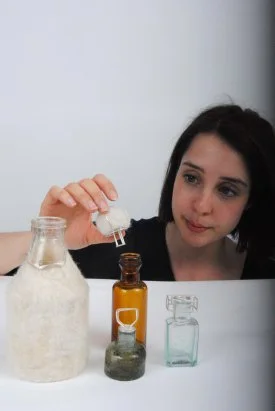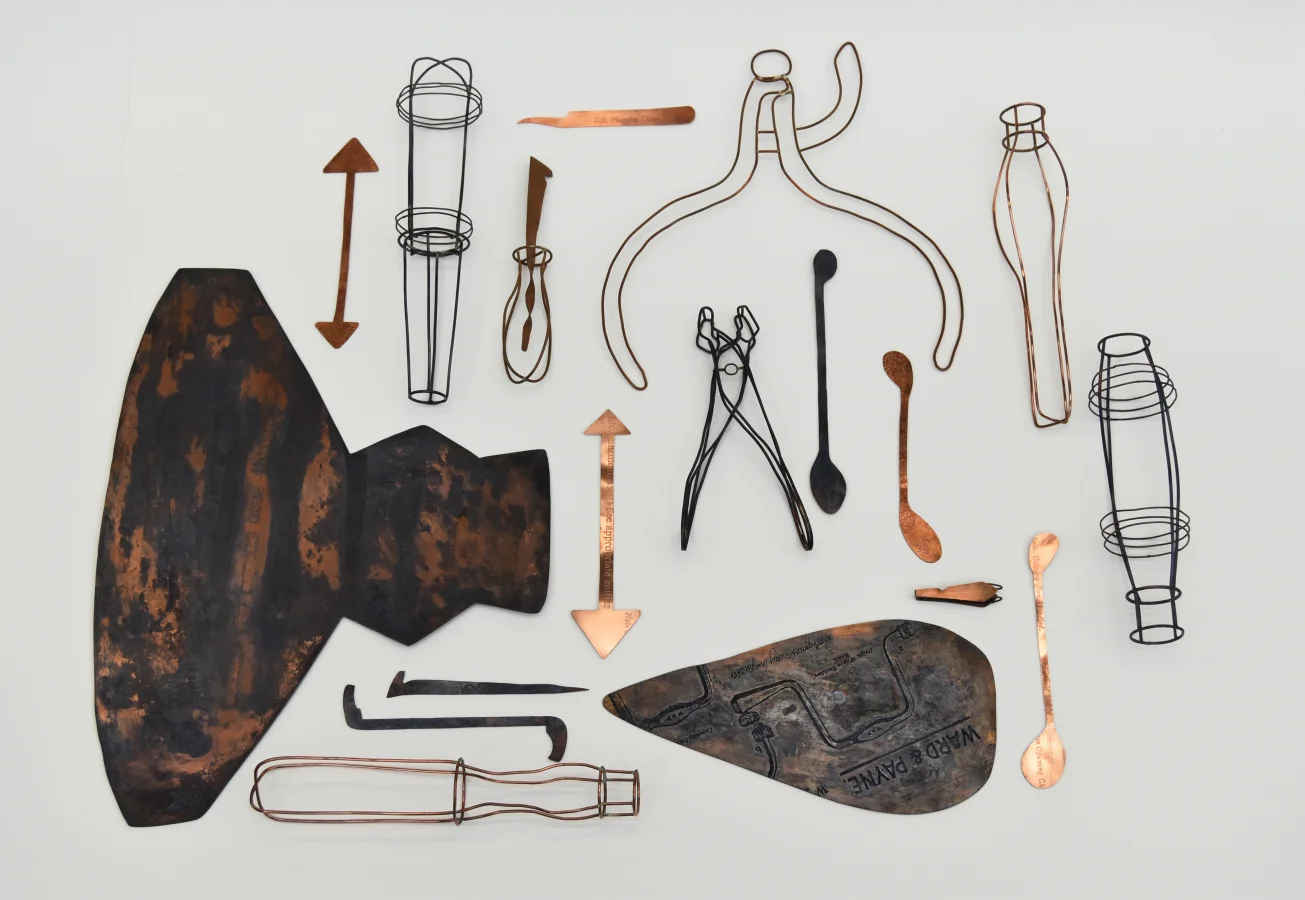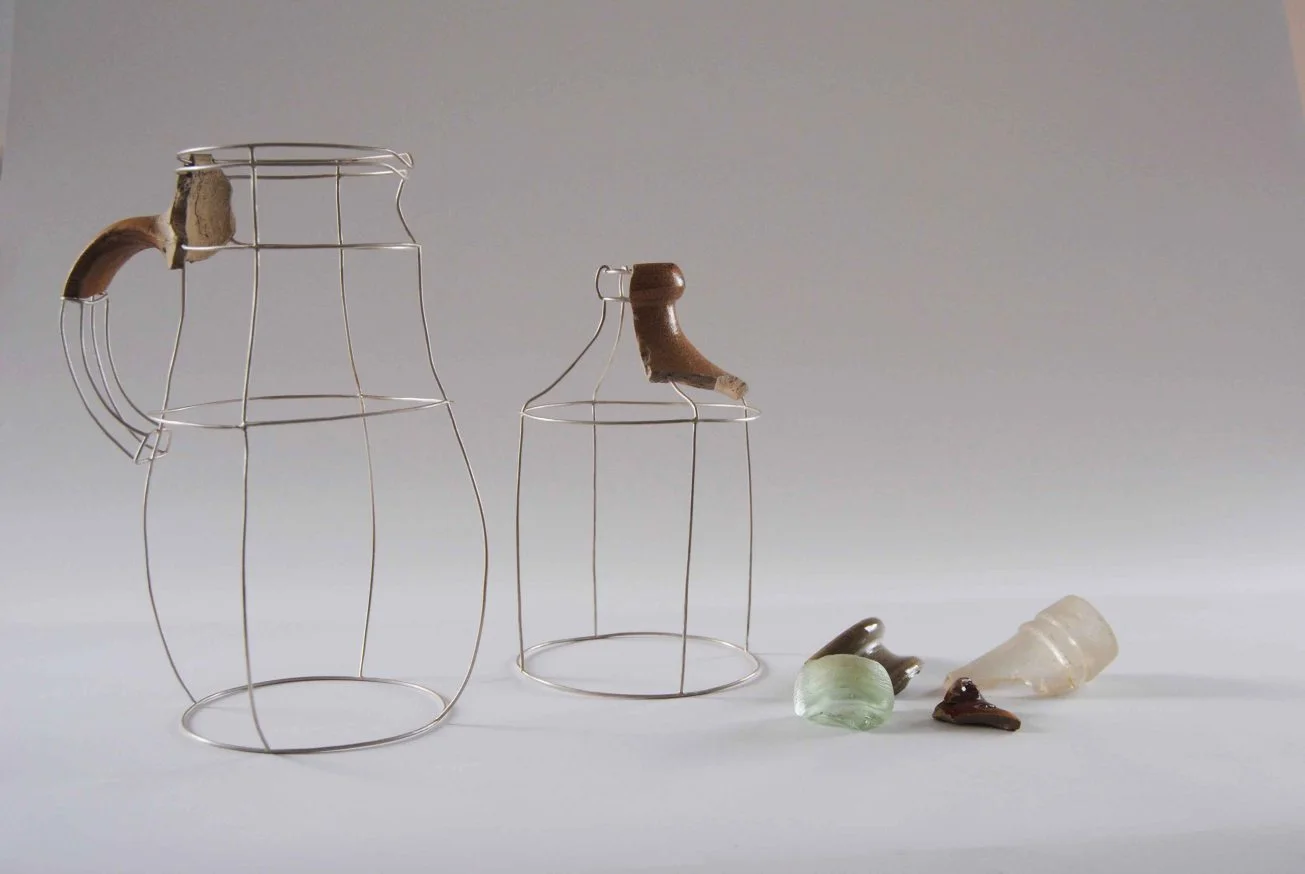This month there is a bonus Wednesday so I thought it might be nice to invite a maker to write a guest post and hear a different voice for a bit. I met Katy Gillam-Hull fairly recently, at New Designers One Year On, and due to the nature of her work (with found, historical objects) I felt like I was talking to a kindred spirit. I’ve been interested to hear her talk, recently, of a change in her practice, or the need to think about a change, so I asked her if she wouldn’t mind putting her thoughts down into words, to elucidate the current state of her making practice. Enjoy!
I am an Artist and Maker of contemporary jewellery and objects, and am mostly inspired by small curiosities found in archives and on shorelines. Working within these contexts I create installations and objects that encourage the viewer to slow down and take a second look, to appreciate the value of a seemingly worthless object. Engaging the viewer with a playfully tactile combination of materials like silver, fleece and glass.
Because of these inspirations I find contemporary craft at its most exciting as an installation that reveals historical ideas and objects, and encourages new and innovative ways to engage with them. This historical residency focus is now becoming a main aim for my career, fuelled by a rediscovery of my passion for historical research and new inspirations in every museum and national trust visit.
Recently I was asked how I go about making and developing new work and I found myself unable to respond; it actually took me a while to think of an answer. I was suddenly aware that in the midst of certainty in where I wanted my work installed, I still had very little knowledge of my own process. I can tell you what I am inspired by, where I’ve found the objects I work with and how I feel about them. I can tell you about the silver wire work style I rely on, but I can’t explain why.
It seems that I have become so used to my practice being a reaction to a sudden need for stock for whatever show or exhibition I am preparing for last minute, that I haven’t stopped to think about how and why I make in a long time.
I do think that reacting to external briefs can be really useful and inspiring to a practice, for example my residency at St Albans Museum which gave me a year of regular work after my degree. It challenged me and supported me as a young maker and made me realise that my work belongs in that environment, intervening in the unexpected location of a museum or historical building.
But as I work towards a future of flitting between new inspiring locations and commissions I can’t forget that the other purpose of a residency is to intervene in and shake up your own thinking and practice. However, how it can do that for me if I don’t have a continuous sustained practice? Instead of that exciting and freeing opportunity to learn new things which a residency can offer, I worry that it can instead overwhelm and consume a fragile practice.
This future of an ‘unsustainable practice’ is a reality I am truly starting to fear. When I say unsustainable I don’t mean financially, alas that is a whole other issue itself, instead I mean that I will be relying on the next funding application, residency and location to sustain my creativity and making. That in the inevitable breaks between these my making would stop still and fall flat, a state I currently find myself in.
I am sure that many makers and artists have felt something like this, a post-show or deadline blues, when you need to pick yourself up and get making again. For some people the answer to this is regular making that can financially and maybe even creatively sustain you, your bread-and-butter practice that appeals to your stockists and galleries. But this answer relies on you having a commercial aspect of your practice, and that’s not for everyone. So, what if you don’t have regular work or stockists, and make more unique or conceptual pieces? What if, even more unhelpfully, like me, you are a multi-disciplinary maker changing material or technique every project? How can you effectively sustain your own creativity in the midst of uncertainty?
It is in this development period I often wish I had a clear and appealing style, the ease of going back to a familiar material and technique that can sustain my making. That would also help my practice to become known and easily recognisable. But as appealing as that sounds it also sounds oppressive to me; I know that I love too many materials to ever pick one and that combinations of them are even more exciting to me. I am also wary of the race for a style, that it might look good from the outside, but we can forget the experiments and failures that were needed for that maker to get there. It can also stifle future experimentation with the fear of failing after success of previous work, or even the pressure to adhere to your own style lest you confuse your audience.
When I look at the artists and makers I admire I realise that it is possible to balance all these ideas within your practice: that Wendy Ramshaw makes multidisciplinary, experimental yet cohesive work and still retains an audience. Or that Edmund de Waal can have a clear style and form but still is willing to play with and subvert it throughout his career, and also to delve in to writing and music alongside his practice. The question is: how can I root my own making personally so as to make work as confident and exciting as the people who inspire me?
I think that the answer to this lies in that aspect of rooting and sustaining your creativity, knowing what it is that helps you to develop your work and creating space for it. For some that could be time away from the studio to write, or space to think and analyse your work. I find these techniques quite easy to do and indeed this piece of writing is part of it. What I am bad at is creating a space for experiments in my making, which is key to my material fluency and practice. I am now seeking for routines that can encourage me, creating safe spaces for playful making without the pressure of an end product, therefore without the fear of failure. I remembered the process of making test samples in my degree which we presented alongside final pieces showing the mistakes we had to make to get to the perfect version. I’m so glad I was taught this basic skill alongside using notebooks and sketchbooks to track and analyse my making, a routine I will pick up again I’m sure.
However recently I have been particularly inspired by Elaine Bolt, a ceramist who combines minimal vessels with beautiful found natural objects. I heard of how she regularly plays with her collection of twigs and bark, making new tiny components out of them with porcelain and other additions. She will then put them back in to her collection. It is only later on in her process she will go back to forage through her own work and findings to select and adjust components to make her exquisite final pieces.
As an artist who has a huge collection of found objects that inspire my work, I find this so fascinating. Particularly the ability to make work then create this distance from it, and being able to look back through it as material library, picking what you need and leaving the rest for the right time. It makes the found object and handmade work equal, it levels the playing field and demands the same amount of respect for both. Which is something I realise I don’t have, I probably respect and love my found fragments more than my own making, as I have often made complimentary not collaborative works. This is a scary realisation to have about your main source of inspiration, but I feel like it’s easy to lose respect for your own samples and mistakes, no matter the material or discipline. Instead through this process you can validate them as useful markers of your development or even as future pieces.
It is exactly this kind of regular making and analysis that I want to strengthen and sustain my creativity, I think this frequent playful routine will particularly feed the multitude of materials I use. And so, I will continue to explore if this regular experimentation can work for me, giving it time and dedication throughout the storm of deadlines and new inspirations.



